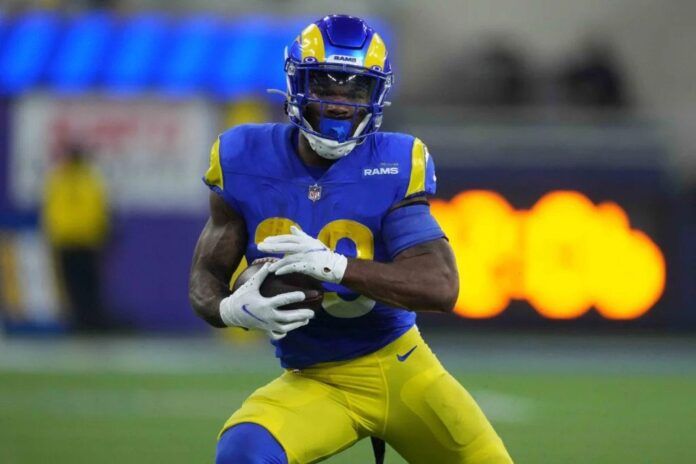The Los Angeles Rams won Super Bowl 56 on the strength of Matthew Stafford’s arm, Sean McVay’s playbook, and the club’s passing attack. McVay has no reason to turn back the clock to 2018 and lean more heavily into the run while Stafford is in town.
But as defenses across the league continue to morph specifically to stop the McVay/Kyle Shanahan passing offense, the Rams may need to sprinkle in more runs. Nearly 14 months removed from his Achilles tear, can Cam Akers capitalize on the promise he showed in 2020?
How Cam Akers affects the Rams’ run game now that he’s healthy
There’s no denying Akers made a valiant effort in returning from a torn Achilles in just six months. As Dylan Hernandez of the Los Angeles Times detailed in January, Akers’ surgery and rehab process was explicitly designed to get the 2020 second-round pick back on the field ahead of schedule.
However, Akers struggled upon his return. He handled five carries in the Rams’ Week 18 game against the 49ers, then rushed the ball 67 times through LA’s Super Bowl run. The results weren’t pretty.
Akers was incredibly inefficient, averaging just 2.43 yards per carry. Among the backs who matched Akers’ 72-carry total in 2021, he ranked 62nd out of 62 in rushing yards over expectation (RYOE). And just two of his attempts went for 10+ yards, a signal that Akers’ Achilles injury may have affected his burst.
The now-23-year-old was far more effective in 2020 when he handled 191 attempts as the Rams’ leading rusher. Akers averaged 4.43 yards per carry and finished 25th in RYOE.
Akers has shown the ability to be an above-average NFL running back, but his productivity was clearly hampered by his Achilles tear. Can the Rams simply hope Akers returns to his previous level of play now that he’s further removed from the injury?
Achilles tears are typically devastating for RBs
Last summer, CBS Sports’ Chris Towers looked at the history of running backs who’d suffered Achilles tears, and there’s hardly a success story among the group. From LenDale White in 2011 to Isaiah Crowell in 2019, nearly every RB who tore his Achilles was out of the NFL almost instantly.
Achilles victim D’Onta Foreman was healthy enough to receive 133 carries in 2021, but it was the first serious workload he’d received since his rookie campaign in 2017. Akers will continue to be an Achilles test case in 2022, as will Jaguars running back James Robinson (injured on Dec. 26, 2021) and Giants receiver Sterling Shepard (injured on Dec. 20).
Players are returning quicker and quicker from Achilles tears thanks to advances in medical processes. As examined by ESPN’s Tim McManus in 2017 and The Athletic’s Stephen Holder in 2021, some NFL teams are now more willing to take chances on players with Achilles injuries, but it can depend on the position.
“Skill position players have to do more quick cutting as opposed to an offensive lineman, which is more of a structured position,” Cincinnati Reds medical director Timothy Kremchek told Holder. “There’s less reactive jumping, twisting, and those types of things. It’s not that they can’t come back to that level. It’s just that it’s hard to do that in six months.”
Akers didn’t look ready during the postseason, but that doesn’t mean he won’t be more successful now that he’s further removed from his injury. For his part, Akers believes he’s set up for a fruitful campaign.
“I know I’m healthy,” Akers told reporters on Tuesday. “Everybody else will just get to see [on Thursday]. I’m not trying to go show anybody that I’m healthy. I’m just going to play my game.”
What else needs to go right for the Rams’ run game?
Obviously, given that he only appeared in five games last season, Akers wasn’t the only problem in LA’s rushing plan. The Rams ranked 19th in EPA/play and 25th in both rushing yards and yards per carry.
Neither of Los Angeles’ leading rushers — Sony Michel and Darrell Henderson Jr. — was efficient in 2021, as both posted negative RYOE. Michel is now off the roster, but Henderson is still around, and the Rams expect him to be a large part of their offense.
“I look at it as we’ve got two starting backs,” McVay told reporters in July. “Those guys are great complements [to] one another, but I see them as both starting-caliber players. We need to get them involved. They need to be on the field. I think it’s healthy for them to be able to supplement one another.”
Henderson has dealt with injury issues of his own, and he’s never completed a full season. Both he and Akers were briefly sidelined by soft-tissue injuries over the summer. But if Los Angeles can use their backs as a 1A and 1B, it could lighten the load and expectations for each individual runner.
The Rams’ offensive line was solid in both pass protection and in the run game last season, but they lost their best lineman, Andrew Whitworth, to retirement. At right guard, Coleman Shelton represents a significant step down from Austin Corbett.
LA has one of the NFL’s best run-blocking wide receivers in Cooper Kupp, but the Rams’ front five won’t get much help from two-tight end sets. McVay ran the most 11 personnel (1 RB, 1 TE, 3 WRs) in the league last year, but LA used 12 personnel just 12% of the time, the fourth-lowest rate in the NFL.
A dependable run game — one that ranks in the top 12 of the league in EPA/play — could help the Rams avoid any regression from their defense and overcome any problems that may arise from Stafford’s supposedly healthy elbow. Akers will be central to that effort, and he’ll get his first chance to prove he’s healthy against the Bills on Thursday night.

